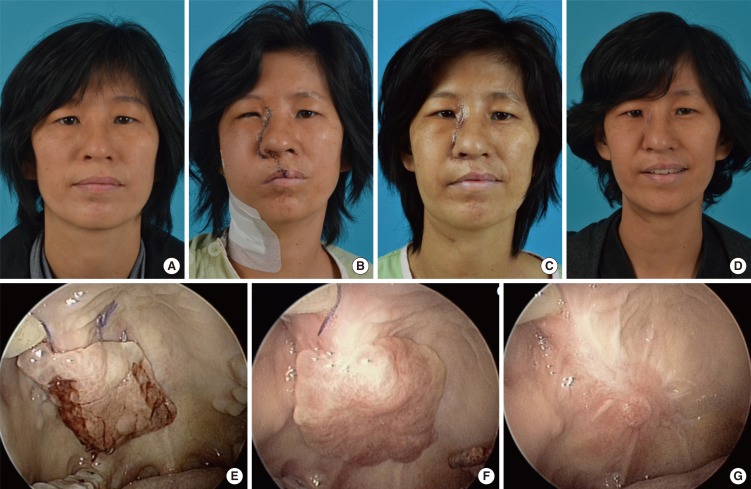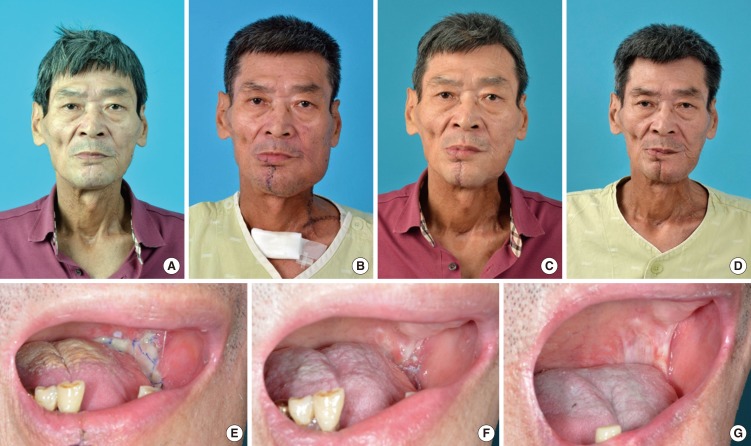Clin Exp Otorhinolaryngol.
2015 Dec;8(4):422-429. 10.3342/ceo.2015.8.4.422.
Scapular Tip Free Flap for Head and Neck Reconstruction
- Affiliations
-
- 1Department of Otorhinolaryngology-Head and Neck Surgery, Sungkyunkwan University School of Medicine, Seoul, Korea. chunghwan.baek@gmail.com
- 2Department of Otorhinolaryngology-Head and Neck Surgery, Inje University Ilsan Paik Hospital, Inje University School of Medicine, Goyang, Korea.
- 3Department of Otorhinolaryngology-Head and Neck Surgery, Pusan National University Hospital, Busan, Korea.
- KMID: 2128921
- DOI: http://doi.org/10.3342/ceo.2015.8.4.422
Abstract
OBJECTIVES
Head and neck reconstruction is still challenging in terms of esthetic and functional outcomes. This study investigated the feasibility of the angular branch-based scapular tip free flap (STFF).
METHODS
This was a retrospective study of 17 patients undergoing maxillectomy and mandibulectomy and either primary or secondary reconstruction by STFF. This study included surgical, esthetic, and functional outcomes, and detailed data are presented regarding the flap, such as pedicle length, size of the harvested bone, and failure rate. Medical photographs were used to estimate the esthetic outcome, and computed tomography was used to check the flap status postoperatively.
RESULTS
The data were collected from April 2013 to April 2014. Eight patients underwent maxillary reconstruction, and nine underwent mandibular reconstruction. Maxillary defects usually included unilateral alveolar structures and the palate; mandibular defects were usually those involving mandibular angle and short segment. Vein grafting was not required in any of the patients. Flap failure occurred in one of the 17 patients (5.9%) with successful reconstruction after revision. Of the eight maxillectomy patients, orbital revisions for diplopia after maxillary reconstruction were performed in two patients (25%), and oroantral fistula repair was performed in one patient (12.5%).
CONCLUSION
This study demonstrated the reconstructive advantages of the angular branch-based STFF, long pedicle, low flap failure, 3-dimensional nature of bone and soft tissues (chimeric flap), and small rate of donor site morbidity with free ambulation. This flap is an excellent option for use in complex three-dimensional head and neck reconstruction.
MeSH Terms
Figure
Reference
-
1. Dowthwaite SA, Theurer J, Belzile M, Fung K, Franklin J, Nichols A, et al. Comparison of fibular and scapular osseous free flaps for oromandibular reconstruction: a patient-centered approach to flap selection. JAMA Otolaryngol Head Neck Surg. 2013; 3. 139(3):285–292. PMID: 23657276.2. Moukarbel RV, White JB, Fung K, Franklin JH, Yoo JH. The scapular free flap: when versatility is needed in head and neck reconstruction. J Otolaryngol Head Neck Surg. 2010; 10. 39(5):572–578. PMID: 20828522.3. Gibber MJ, Clain JB, Jacobson AS, Buchbinder D, Scherl S, Zevallos JP, et al. Subscapular system of flaps: an 8-year experience with 105 patients. Head Neck. 2015; 8. 37(8):1200–1206. PMID: 24800735.
Article4. Valentini V, Gennaro P, Torroni A, Longo G, Aboh IV, Cassoni A, et al. Scapula free flap for complex maxillofacial reconstruction. J Craniofac Surg. 2009; 7. 20(4):1125–1131. PMID: 19506522.
Article5. Miles BA, Gilbert RW. Maxillary reconstruction with the scapular angle osteomyogenous free flap. Arch Otolaryngol Head Neck Surg. 2011; 11. 137(11):1130–1135. PMID: 22106238.
Article6. Piazza C, Paderno A, Taglietti V, Nicolai P. Evolution of complex palatomaxillary reconstructions: the scapular angle osteomuscular free flap. Curr Opin Otolaryngol Head Neck Surg. 2013; 4. 21(2):95–103. PMID: 23385785.7. Coleman JJ 3rd, Sultan MR. The bipedicled osteocutaneous scapula flap: a new subscapular system free flap. Plast Reconstr Surg. 1991; 4. 87(4):682–692. PMID: 2008466.8. Clark JR, Vesely M, Gilbert R. Scapular angle osteomyogenous flap in postmaxillectomy reconstruction: defect, reconstruction, shoulder function, and harvest technique. Head Neck. 2008; 1. 30(1):10–20. PMID: 17636540.
Article9. Pagedar NA, Gilbert RW, Chan H, Daly MJ, Irish JC, Siewerdsen JH. Maxillary reconstruction using the scapular tip free flap: a radiologic comparison of 3D morphology. Head Neck. 2012; 10. 34(10):1377–1382. PMID: 22287228.
Article10. Yoo J, Dowthwaite SA, Fung K, Franklin J, Nichols A. A new angle to mandibular reconstruction: the scapular tip free flap. Head Neck. 2013; 7. 35(7):980–986. PMID: 22847980.
Article11. Okay DJ, Genden E, Buchbinder D, Urken M. Prosthodontic guidelines for surgical reconstruction of the maxilla: a classification system of defects. J Prosthet Dent. 2001; 10. 86(4):352–363. PMID: 11677528.
Article12. Deleyiannis FW, Rogers C, Lee E, Russavage J, Gastman B, Dunklebarger J, et al. Reconstruction of the lateral mandibulectomy defect: management based on prognosis and location and volume of soft tissue resection. Laryngoscope. 2006; 11. 116(11):2071–2080. PMID: 17075408.
Article13. Nishimura T, Furukawa M, Koshima I. Scapular bone flap harvests of patients in a supine position. Laryngoscope. 2004; 6. 114(6):1130–1132. PMID: 15179227.
Article14. dos Santos LF. The vascular anatomy and dissection of the free scapular flap. Plast Reconstr Surg. 1984; 4. 73(4):599–604. PMID: 6709742.
Article15. Seneviratne S, Duong C, Taylor GI. The angular branch of the thoracodorsal artery and its blood supply to the inferior angle of the scapula: an anatomical study. Plast Reconstr Surg. 1999; 7. 104(1):85–88. PMID: 10597678.
Article16. Seitz A, Papp S, Papp C, Maurer H. The anatomy of the angular branch of the thoracodorsal artery. Cells Tissues Organs. 1999; 7. 164(4):227–236. PMID: 10436331.
Article17. Brown JS, Jones DC, Summerwill A, Rogers SN, Howell RA, Cawood JI, et al. Vascularized iliac crest with internal oblique muscle for immediate reconstruction after maxillectomy. Br J Oral Maxillofac Surg. 2002; 6. 40(3):183–190. PMID: 12054706.
Article18. Rogers SN, Lowe D, McNally D, Brown JS, Vaughan ED. Health-related quality of life after maxillectomy: a comparison between prosthetic obturation and free flap. J Oral Maxillofac Surg. 2003; 2. 61(2):174–181. PMID: 12618993.
Article19. Corbitt C, Skoracki RJ, Yu P, Hanasono MM. Free flap failure in head and neck reconstruction. Head Neck. 2014; 10. 36(10):1440–1445. PMID: 24038609.
Article20. van Gemert JT, van Es RJ, Rosenberg AJ, van der Bilt A, Koole R, Van Cann EM. Free vascularized flaps for reconstruction of the mandible: complications, success, and dental rehabilitation. J Oral Maxillofac Surg. 2012; 7. 70(7):1692–1698. PMID: 22079062.
Article21. Kim SH, Kim DW, Kim H, Kim DY, Rhee CS, Hah JH. Reconstruction of maxilla and midface with microvascular free flaps. Korean J Otorhinolaryngol-Head Neck Surg. 2013; 10. 56(10):642–646.
Article
- Full Text Links
- Actions
-
Cited
- CITED
-
- Close
- Share
- Similar articles
-
- Lateral Arm Free Flap for Oral Cavity and Oropharyngeal Reconstruction
- The Free Scapular Flap
- Free Vasularized Scapular and Parascapular Flap
- Six Cases of Reconstruction with Latissimus Dorsi Pedicled Flap for Head and Neck Defects in the Era of Free Flap Reconstruction
- Reconstruction of the mandible and soft tissue using the free osteocutaneous scapular flap





